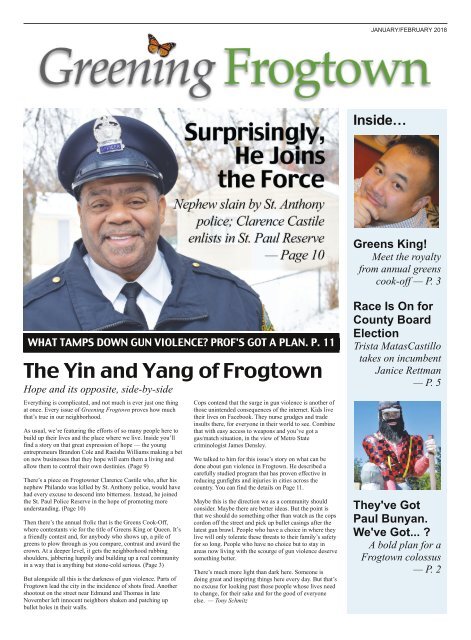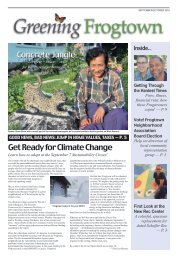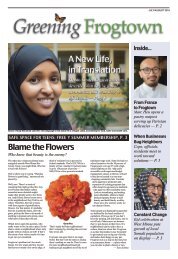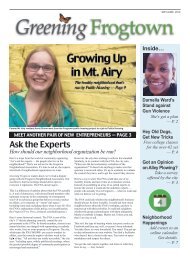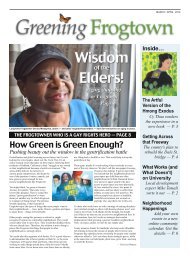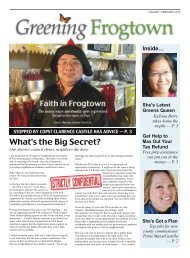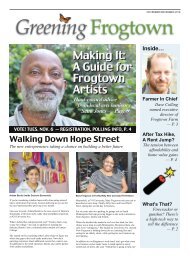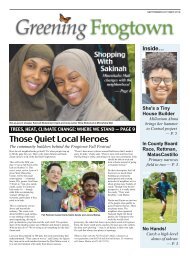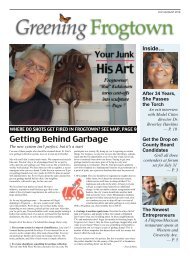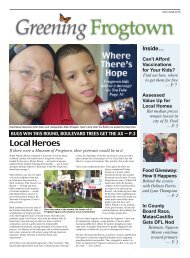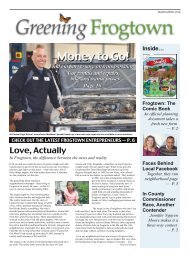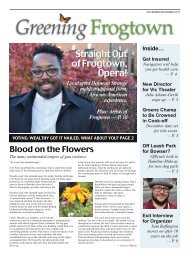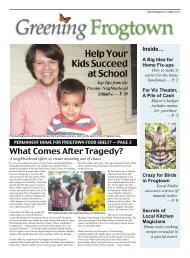GreeningFrogtownJanFeb18FINAL
You also want an ePaper? Increase the reach of your titles
YUMPU automatically turns print PDFs into web optimized ePapers that Google loves.
JANUARY/FEBRUARY 2018<br />
Inside…<br />
Greens King!<br />
Meet the royalty<br />
from annual greens<br />
cook-off— P. 3<br />
WHAT TAMPS DOWN GUN VIOLENCE? PROF'S GOT A PLAN. P. 11<br />
The Yin and Yang of Frogtown<br />
Hope and its opposite, side-by-side<br />
Everything is complicated, and not much is ever just one thing<br />
at once. Every issue of Greening Frogtown proves how much<br />
that’s true in our neighborhood.<br />
As usual, we’re featuring the efforts of so many people here to<br />
build up their lives and the place where we live. Inside you’ll<br />
find a story on that great expression of hope — the young<br />
entrepreneurs Brandon Cole and Raeisha Williams making a bet<br />
on new businesses that they hope will earn them a living and<br />
allow them to control their own destinies. (Page 9)<br />
There’s a piece on Frogtowner Clarence Castile who, after his<br />
nephew Philando was killed by St. Anthony police, would have<br />
had every excuse to descend into bitterness. Instead, he joined<br />
the St. Paul Police Reserve in the hope of promoting more<br />
understanding. (Page 1 0)<br />
Then there’s the annual frolic that is the Greens Cook-Off,<br />
where contestants vie for the title of Greens King or Queen. It’s<br />
a friendly contest and, for anybody who shows up, a pile of<br />
greens to plow through as you compare, contrast and award the<br />
crown. At a deeper level, it gets the neighborhood rubbing<br />
shoulders, jabbering happily and building up a real community<br />
in a way that is anything but stone-cold serious. (Page 3)<br />
But alongside all this is the darkness of gun violence. Parts of<br />
Frogtown lead the city in the incidence of shots fired. Another<br />
shootout on the street near Edmund and Thomas in late<br />
November left innocent neighbors shaken and patching up<br />
bullet holes in their walls.<br />
Cops contend that the surge in gun violence is another of<br />
those unintended consequences of the internet. Kids live<br />
their lives on Facebook. They nurse grudges and trade<br />
insults there, for everyone in their world to see. Combine<br />
that with easy access to weapons and you’ve got a<br />
gas/match situation, in the view of Metro State<br />
criminologist James Densley.<br />
We talked to him for this issue’s story on what can be<br />
done about gun violence in Frogtown. He described a<br />
carefully studied program that has proven effective in<br />
reducing gunfights and injuries in cities across the<br />
country. You can find the details on Page 11 .<br />
Maybe this is the direction we as a community should<br />
consider. Maybe there are better ideas. But the point is<br />
that we should do something other than watch as the cops<br />
cordon off the street and pick up bullet casings after the<br />
latest gun brawl. People who have a choice in where they<br />
live will only tolerate these threats to their family’s safety<br />
for so long. People who have no choice but to stay in<br />
areas now living with the scourge of gun violence deserve<br />
something better.<br />
There’s much more light than dark here. Someone is<br />
doing great and inspiring things here every day. But that’s<br />
no excuse for looking past those people whose lives need<br />
to change, for their sake and for the good of everyone<br />
else. — Tony Schmitz<br />
Race Is On for<br />
County Board<br />
Election<br />
Trista MatasCastillo<br />
takes on incumbent<br />
Janice Rettman<br />
— P. 5<br />
They've Got<br />
Paul Bunyan.<br />
We've Got... ?<br />
A bold plan for a<br />
Frogtown colossus<br />
— P. 2
It's Colossus Time<br />
BIG IDEAS<br />
A giant sculpture to honor Hmong contributions to Frogtown<br />
Colussus of Rhodes Alexandria's Big Ole<br />
Paul Bunyan in Akeley Frogtown's Bunyan & Babe the Ox?<br />
By Patricia Ohmans<br />
I’ve got a great big idea—in fact, a<br />
GIANT of an idea. It sprang from a<br />
conversation with Frogtown businessman<br />
Toua Xiong, the energetic owner of<br />
Hmongtown Marketplace on Como<br />
Avenue. Toua thinks that the corner<br />
opposite his market—the five-point<br />
convergence of Marion and Como, needs<br />
some art. Giant art, to be exact. He’d like<br />
to see giant statues of Hmong gods, like<br />
ones he’s visited in Laos, near the former<br />
refugee camps where he spent some time<br />
as a young man.<br />
As I said, great idea…but in my view,<br />
this doesn’t go far enough. Given the<br />
incredible and often unacknowleged<br />
contributions of Hmong people to<br />
Frogtown’s vibrant life and economy, I<br />
think someone should the build the<br />
World’s Largest Hmong Couple to stand<br />
at that intersection. Minnesota’s got<br />
plenty of giant memorials to powerful<br />
immigrant workers. Why not add Hmong<br />
immigrants to that heroic roster?<br />
Our love of giant, commemorative<br />
sculptures probably began with the<br />
Colossus of Rhodes, one of the Seven<br />
Wonders of the Ancient World,. At 1 08<br />
feet high, it was about as tall as the Statue<br />
of Liberty from feet to crown. Minnesota<br />
has erected many such colossal<br />
companions over the years. Check out<br />
historian Karal Ann Marling’s book, The<br />
Colossus ofRoads (get it?) for more<br />
examples, but consider:<br />
The World’s Largest Paul Bunyan statue,<br />
is in Akeley, Minnesota (population 432).<br />
He’s the ‘World’s Largest' — “if he stood<br />
up,” according to his creators. This guy<br />
kneels gently with a concrete hand<br />
outstretched, the better to provide photo<br />
ops for visitors who find Bemidji’s boxier<br />
and more famous Paul Bunyan too macho.<br />
— Continued, Page 9<br />
PAGE 2 JANUARY/FEBRUARY JULY / AUGUST 2018<br />
6
FROGTOWN NEWS<br />
Manager Simona Zappas (front), and development director Catherine Warner.<br />
For Ultra‐Local WFNU, a New Home<br />
Frogtown’s low-power radio station,<br />
WFNU (94.1 FM) got a new home in the<br />
basement at Faith Lutheran Church at 499<br />
Charles Ave., with a move that started in<br />
mid-October.<br />
By late November it was still a work in<br />
progress. A studio space with a new sound<br />
board, mics, and wiring was ready to go.<br />
Other studio space remained to be<br />
completed in what was at the moment<br />
eccentric surroundings. Station manager<br />
Simona Zappas and development director<br />
Catherine Warner described their plans to<br />
convert a locker room — still equipped<br />
with lockers, a toilet and dripping sink —<br />
into a office, with another studio planned<br />
for the adjacent shower room.<br />
According to Zappas and Warner, the new<br />
space has big advantages over their<br />
former home in a second-floor back room<br />
on University Ave. For instance,<br />
functioning electrical outlets and no mice.<br />
The new space also offers possibilities for<br />
live shows or other events in the church<br />
basement basketball court that’s next door<br />
to the studios.<br />
JANUARY/FEBRUARY 2018<br />
It’s all part of the station’s growth since it<br />
started broadcasting in August, 201 6. Like<br />
other low-power stations, the broadcast<br />
range is narrow — the signal from a<br />
transmitter on top of the Episcopal Homes<br />
building at Dale and University reaches a<br />
little past 280 to the west and 35E to the<br />
east. But the idea behind such stations is<br />
to feature hyper-local news and<br />
entertainment.<br />
The station now has about 60 people<br />
producing shows, with 70 percent of the<br />
content broadcast live on an all-day, every<br />
day schedule.<br />
The station’s growth plan goes like this:<br />
contract with community groups to<br />
produce podcasts that highlight their<br />
programs and generate revenue. Train<br />
station DJs to create podcasts, and to help<br />
them develop marketable skills. Use the<br />
earned income to show foundation funders<br />
that the station has means to sustain itself.<br />
Learn more about the station — and scope<br />
out the scheduled programming — at<br />
WFNU.org.<br />
Your Mom Says, Shovel that Walk!<br />
A reminder for the winter months: when<br />
you don’t shovel your sidewalk, you’re<br />
imprisoning the elderly and parents with<br />
strollers.<br />
Fighting your<br />
way across<br />
snow-clogged<br />
sidewalks is<br />
dangerous for the<br />
old, and<br />
frustrating for<br />
parents with<br />
young kids.<br />
Tired of that<br />
neighbor who<br />
doesn’t get it?<br />
You can drop the<br />
dime by calling<br />
651 -266-8989 if<br />
sidewalks aren’t<br />
cleared within 24<br />
hours of a<br />
snowfall. The non-shoveler will get a<br />
letter from the city Department of Safety<br />
and Inspections, and have a 24-hour<br />
window to start heaving snow. If an<br />
inspector finds the sidewalk<br />
still isn’t cleared a day later,<br />
a city crew will be<br />
dispatched to do the job.<br />
Government work isn’t<br />
cheap. City shovelers work<br />
for $1 60 an hour with a<br />
half-hour minimum. It’s<br />
another $80 per hour with a<br />
half-hour minimum if your<br />
sidewalk needs salt and<br />
sand. Plus there’s a $35<br />
administrative charge.<br />
If you’re elderly or disabled<br />
and simply can’t do the job,<br />
call 651 -266-8989, explain<br />
your situation and you’ll get<br />
connected with agencies that<br />
can get your sidewalk cleared.<br />
Greens King and Queen, Crowned<br />
If you wanted to explore the world of<br />
greens cookery, the second annual Greens<br />
Cook-off at Pilgrim Baptist church was<br />
the place to be on December 2. The event,<br />
sponsored by the Urban Farm and Garden<br />
Alliance, drew 1 2 contestants who each<br />
brought in a pile of cooked greens to be<br />
sampled by a panel of local celebrity<br />
judges and by the roughly 200 people<br />
who packed the church basement.<br />
At stake? The title of Greens Queen or<br />
King, a certificate stating as much, and<br />
bragging rights for a year.<br />
Most contestants started with collards,<br />
though even at this level paths diverged.<br />
Some added in mustard greens, kale and<br />
spinach, or went entirely with Chinese<br />
broccoli. Then there was the question of<br />
meat. Ham shanks? Turkey? If turkey,<br />
smoked tails, neck bones or wings? What<br />
about peppers? Chipotles? Serranos?<br />
Chili flakes? Vinegar or no? Onions?<br />
Garlic?<br />
While the local celeb judges made their<br />
determinations, the crowd stepped up to<br />
declare a winner in the People’s Choice<br />
category. Everyone had three stickers to<br />
award to the entries they considered the<br />
tastiest.<br />
In the end, tradition<br />
and innovation<br />
both got their due.<br />
In the celeb<br />
judging category,<br />
Rondo resident<br />
and Community<br />
Stabilization<br />
Project codirector<br />
Carolyn Brown<br />
took home the<br />
prize with an<br />
old-school<br />
collard recipe<br />
handed down<br />
from her<br />
Mississippiraised<br />
relation.<br />
Yeng<br />
Moua, a<br />
University<br />
of Minnesota<br />
Extension worker<br />
with a Frogtown<br />
focus, won with a<br />
more lightly cooked<br />
greens dish based on<br />
his mother’s cooking<br />
style that used —<br />
here’s a shocker —<br />
Chinese broccoli as<br />
its base.<br />
For Carolyn Brown,<br />
the road to the top<br />
Do You Need Tax Time Help?<br />
Filing taxes can be a mind-bender, but<br />
you can get free help from the St. Paulbased<br />
organization Prepare and Prosper.<br />
The non-profit organization offers free tax<br />
and financial services to individuals who<br />
earn less than $35,000, families that make<br />
started with smoked turkey wings, which<br />
she simmered for about an hour in water<br />
and salt. Next she added a pile of collard<br />
greens, which she simmered for another<br />
hour. In the last 1 5 minutes she dropped a<br />
Serrano pepper — one of those spiky red<br />
peppers that looks like a devil’s horn —<br />
into the pot.<br />
So what’s the secret ingredient? By<br />
Brown’s account, it’s that the greens<br />
came straight out of the garden, along<br />
with some other collards that had been<br />
harvested earlier and frozen. Same with<br />
the pepper. It was grown, not bought.<br />
“That’s a whole different taste and texture<br />
from store-bought greens. You get more<br />
flavor when it’s from the garden. The<br />
texture is smoother.”<br />
For Moua, simplicity was the key as well.<br />
His complete list of ingredients was the<br />
Chinese broccoli, garlic, olive oil and<br />
oyster sauce. He blanched the broccoli for<br />
about five minutes, then seared it in a<br />
wok with the olive oil, garlic and oyster<br />
sauce.<br />
At the Moua home the dish would have<br />
been moved directly from the stove to the<br />
table. In this case, the broccoli moistened<br />
up while waiting in the crock pot, but the<br />
dish retained a more vibrant green hue<br />
than the other entries.<br />
“This is the<br />
way my mom<br />
would have<br />
done it,”<br />
Moua said,<br />
though he<br />
admitted there<br />
was only so<br />
much he could<br />
learn from her.<br />
“I try to help her<br />
in the kitchen, but<br />
she usually says,<br />
‘Why don’t you go<br />
sit with your<br />
dad?’”<br />
Top: Greens Queen Carolyn Brown. Below: King Deng Moua<br />
$55,000 or less and self-employed<br />
individuals earning $55,000 or less.<br />
Online scheduling for the 201 7 tax season<br />
opens at prepareandprosper.org on Jan.<br />
11 . Questions? Call 651 287-01 87.<br />
PAGE 3
PAGE 4 NOVEMBER/DECEMBER 2017
For County Board<br />
Seat, the Race Is On<br />
You might think, wait, didn’t I just vote?<br />
But there’s always another political race<br />
around the corner. The next big local seat<br />
up for grabs is the County Commissioner<br />
position. Although this race is still mostly<br />
under the radar, it will be a focus of<br />
attention at the February 6 party caucuses,<br />
when DFL and Republican party activists<br />
get together to begin the process of<br />
deciding who, if anyone, will get the party<br />
endorsements. So far it’s a race between<br />
incumbent Janice Rettman and DFL<br />
challenger Trista MatasCastillo.<br />
Rettman has held the seat for 20 years after<br />
serving 1 0 years on the St. Paul City<br />
Council. Her district includes wildly<br />
different communities, ranging from<br />
Frogtown to Falcon Heights, to the Como<br />
Park area, the North End, and a swatch of<br />
the East Side. The responsibilities that<br />
come with the seat are enormous, since the<br />
county’s hand reaches into human services,<br />
parks, libraries, the courts, county law<br />
enforcement, roads, waste, housing and<br />
more.<br />
Rettman has often enjoyed a cakewalk into<br />
office, facing either weak challengers in the<br />
general election or none at all. In 201 4 she<br />
tallied 1 0,779 votes against the 2,953 for<br />
FROGTOWN NEWS<br />
Incumbent Jane Rettman, left, and challenger Trista MatasCastillo. Get involved in the race by participating in the DFL<br />
caucus, 6:30 pm, Tuesday, Feb. 6 at Capitol Hill Magnet School, 560 Concordia Ave., St. Paul.<br />
rival Girard Goder. In 2006 and 201 0,<br />
there was no other candidate for the seat.<br />
This time around, MatasCastillo is<br />
looking to make a strong bid for the DFL<br />
endorsement, and vows that regardless<br />
what happens at the district endorsing<br />
convention, she’ll take the race up to the<br />
August 1 4 primary.<br />
MatasCastillo brings an atypical work<br />
history to this contest. She served 1 6<br />
years in three branches of the military —<br />
the Navy, Marines and Minnesota<br />
National Guard. She was a master<br />
weapons instructor, later went on to work<br />
for Habitat for Humanity and now serves<br />
as aide to Shoreview-area county<br />
commissioner Blake Huffman. She’s also<br />
a Bush Foundation fellow — a highly<br />
sought after award intended to promote<br />
leadership skills — and is founder of the<br />
Women Veterans Initiative, a nonprofit<br />
that assists female veterans. Plus, she and<br />
her husband serve as coaches of a<br />
boy/girl East Side wrestling club.<br />
Rettman, meanwhile, is a familiar face to<br />
thousands of constituents. For a<br />
generation she’s showed up at countless<br />
neighborhood meetings and events,<br />
developing personal relationships with<br />
voters along the way. She had a strong<br />
hand in developing neighborhood-based<br />
clean ups, and in the creation of yard<br />
waste disposal sites. More recently she<br />
was an advocate for the Trout Brook<br />
Nature Sanctuary. But she’s also known<br />
as a lone wolf on the county commission<br />
— often the single no vote amid the ayes<br />
of six other commissioners. That<br />
propensity got her included in a<br />
September StarTribune roundup of local<br />
public officials who are frequently the<br />
sole naysayers among their peers.<br />
Asked to name her priorities,<br />
MatasCastillo speaks to personal issues<br />
that are public policy matters as well.<br />
Her 1 8-year old son is severely autistic<br />
— Continued, Next Page<br />
JANUARY/FEBRUARY 2018<br />
PAGE 5
FROGTOWN NEWS<br />
County Board, Continued<br />
and has required services that flow<br />
through the county. By her description,<br />
she’s fought a battle against bureaucratic<br />
red tape since her son was diagnosed at<br />
the age of 2. “I speak English, I know<br />
how to advocate, and it’s been a struggle,”<br />
she says. “It’s absurd for people who<br />
don’t speak English. Step one is to<br />
improve services so the county really is a<br />
safety net for people who need it.”<br />
By her estimate, MatasCastillo is<br />
$1 00,000 under water on her East Side<br />
home. A three block stretch of her street<br />
held 42 vacant homes after the housing<br />
crash. She sees public investment as a<br />
way to help re-establish value and build<br />
homeowner confidence. “We’ve got to<br />
put sidewalks in so kids aren’t waiting in<br />
the street for a school bus. We’ve got to<br />
reopen the closed rec centers. We’ve lost<br />
sight of what good investments are.<br />
Sometimes you have to spend a little<br />
money. That’s why I’m running — to<br />
make sure there’s equitable investment in<br />
all our neighborhoods. Right now there<br />
isn’t. The suburban areas are doing great.<br />
Highland, Summit are looking good. But<br />
our district?” Among the remedies she<br />
proposes is more focus on partnerships<br />
with unions and other players to increase<br />
awareness of apprenticeship training that<br />
leads to living wage jobs.<br />
Rettman, MatasCastillo says, holds the<br />
checkbook too close. “It isn’t necessarily<br />
wrong, but it won’t move us ahead. If<br />
your peers always know that you’re<br />
going to vote no, it’s really a six member<br />
board. They’ve written her off. They’re<br />
doing a great job advocating for their<br />
districts, but the poorest district — ours<br />
— has no voice.”<br />
Needless to say, that’s not how Rettman<br />
sees it.<br />
“Sometimes a no vote is a yes vote for the<br />
people,” she says. As evidence, she points<br />
to her votes against the development plan<br />
for the Arden Hills Twin Cities Army<br />
Ammunition Plant site, a 427 acre swath<br />
of polluted land bought by the county and<br />
cleared for development.<br />
Rettman says she voted against it because<br />
it didn’t allow for enough affordable<br />
housing or for transit that could take<br />
residents to and from work. Similarly, she<br />
voted against a consolidation of Boys<br />
Totem Town, a facility for troubled youth,<br />
with a Hennepin County operation. Her<br />
fellow commissioners, she says, didn’t<br />
listen to the objections of families with<br />
kids in Totem Town.<br />
Asked to name her priorities for the<br />
district, she starts with job training and<br />
development. The county, she says,<br />
should be working with the schools,<br />
business and training operations like Twin<br />
Cities Rise to prepare young people for<br />
the jobs of the future. Workforce training<br />
and the resulting increased incomes will<br />
lead to more homeowner investment in<br />
housing, she says.<br />
Rettman says she sees her job as creating<br />
equal opportunity. “People have a right to<br />
a job throughout the county. They have a<br />
right to affordable housing throughout the<br />
county. Equal access should be a<br />
fundamental part of what my job is.”<br />
Animal Humane Society trainers Katie Heathcote and Elise Denham Probasco.<br />
Free Help to Get Fido Trained<br />
Does your adorable pet drive you crazy<br />
sometimes? I can relate.<br />
Balto—the huge German shepherd-husky<br />
mix who came to live with us in<br />
August—is handsome, mellow and<br />
affectionate. Everybody likes him, even<br />
the mailman! But often, like when I’m<br />
reading, or eating, Balto sticks his giant<br />
head under my arm and demands<br />
affection, nudging me vigorously so I’ll<br />
pet him. It’s intrusive and annoying, and<br />
when I’m drinking coffee, I’m afraid he’s<br />
going to spill scalding liquid on himself,<br />
or me.<br />
Hoping for some tips, I called Elise<br />
Denham Probasco,at the Outreach<br />
Program of the Animal Humane Society.<br />
Elise a home-visiting pet trainer, helped<br />
me when Balto first arrived this summer,<br />
— Continued, Page 8<br />
PAGE 6<br />
JANUARY/FEBRUARY 2018
Training, Continued<br />
showing me how to manage his desire to<br />
pull—hard—on his leash when we went<br />
for a walk.<br />
Elise showed up again on a cold morning<br />
recently, along with her colleague Katie<br />
Heathcote. Their relaxed visit to our home<br />
is all in a days’ work for the pair, who are<br />
certified animal trainers. Through them,<br />
the Outreach Program provides free<br />
training for four-legged residents of<br />
Frogtown and their owners.<br />
Yes, FREE. Turns out offering free<br />
training actually is a win-win for the<br />
AHS, as well as for pet-owners. “The<br />
Humane Society wants to keep pets and<br />
their owners together,” Katie explained.<br />
“Behavior issues are the number one<br />
reason why people surrender their pets. If<br />
we can help the humans to understand<br />
their pet’s undesirable behavior – and<br />
teach the pet to do something differently –<br />
their bond can improve and the stress in<br />
the home can decrease.”<br />
Recognizing that the cost of keeping a<br />
beloved pet is something else that causes<br />
low-income owners distress, the AHS’s<br />
Outreach Program also hands out free pet<br />
food at our neighborhood’s food<br />
distribution events. Spay-neuter and<br />
vaccinations are offered at very low cost<br />
to residents, and in-home training will be<br />
free “for the foreseeable future,”<br />
according to Elise.<br />
FROGTOWN NEWS<br />
Balto’s behavior is familiar to these<br />
experienced pet trainers, who’ve helped<br />
with everything from fireworks-fearing<br />
schnauzers to shoe-peeing tabbies.<br />
They’ve dealt with a few Frogtown<br />
rabbits and even a guinea pig. Birds, too.<br />
They show up at homes bearing food,<br />
supplies, tools for training, and a bag full<br />
of treats. “We don’t like to recommend<br />
products that folks won’t be able to<br />
afford, and we want people to be able to<br />
implement our recommendations right<br />
away,” says Elise.<br />
As for Balto’s ‘nosiness”, Elise and Katie<br />
advised me, first, to realize that his need<br />
for affection is just part of who he is: a<br />
sweet dog who needs lots of reassurance<br />
and attention. “You can’t really do much<br />
about a pet’s personality, but you can<br />
change their behavior,” Katie said. She<br />
suggested that we designate a<br />
comfortable blanket as Balto’s special<br />
mat, and when he gets too pushy, to train<br />
him to “go to mat” by associating that<br />
action with good things, like praise,<br />
petting and treats.<br />
That tactic works better than shoving him<br />
away, or yelling ‘no,’ Elise said. “It’s<br />
‘important to give pets something<br />
positive to look forward to, rather than<br />
saying ‘no’ all the time,” she cautioned.<br />
“Dogs can’t generalize, so they don’t<br />
really know what ‘no’ means. Just like<br />
toddlers, they’re a lot more responsive if<br />
you give them an alternative to the<br />
behavior you don’t like.”<br />
So, there’s now a zebra-striped fleece<br />
blanket on the kitchen floor that Balto<br />
seems to like, especially if he gets a little<br />
treat for sitting on it. We’re a work in<br />
progress, but Elise and Katie promised to<br />
check in on us in a couple of weeks.<br />
Meanwhile, they were off to help some<br />
other Frogtown pet owner love their pet<br />
more effectively.<br />
Make an appointment for free pet training<br />
by calling or texting Elise Denham<br />
Probasco, AHS Animal Behavior &<br />
Training Specialist, 651-802-824, or email at<br />
edenhamprobasco@animalhumanesociety<br />
.org.<br />
Training is available to residents of<br />
Frogtown, the North End and the near<br />
East side of St Paul.<br />
Top Tips for That Bike Commute<br />
For Thomas Ave. resident<br />
Carol Zierman, winter's<br />
arrival doesn't mean it's<br />
time to put away her bike.<br />
Here are her tips on<br />
managing a cold-weather<br />
bike commute:<br />
How often do you<br />
commute by bike?<br />
I have averaged 3 days a<br />
week as a bike commuter<br />
since I started in August.<br />
If it’s too cold, I don’t do<br />
it. Zero degrees is my cut<br />
off. I have learned when<br />
it is no longer enjoyable<br />
for me and that seems to<br />
be it.<br />
Does your workplace<br />
encourage you to bike?<br />
Ready to Ride: Carol Zierman<br />
The fact that my<br />
employer has a gym and<br />
shower onsite and bike<br />
racks outside our<br />
building were key to<br />
getting me started.<br />
Do you bike to work and<br />
back?<br />
My commute is 8.8<br />
miles. I am able to do<br />
that in about 45 minutes,<br />
depending on stop lights.<br />
I typically bike the whole<br />
way in the morning. But<br />
in the afternoon I bike<br />
from downtown<br />
Minneapolis to the<br />
Stadium Village station<br />
and take the Greenline to<br />
the Fairview or<br />
— Continued, Next Page<br />
PAGE 8<br />
JANUARY/FEBRUARY 2018
FROGTOWN NEWS<br />
Winter Biking, Continued<br />
Lexington station, and then bike the rest<br />
of the way. It has been fun to have the<br />
option to hop on and off the train,<br />
especially when it's cold or really windy.<br />
How is your bike set up for winter?<br />
When the weather started getting cold I<br />
realized my regular road bike wouldn't<br />
work if I wanted to keep biking. I took<br />
my old mountain bike to Cycles for<br />
Change and had them set it up with<br />
studded tires. But then we got no snow!<br />
Just one dusting and gone. It is not really<br />
good to ride studded tires on clear streets,<br />
so I considered a fat bike where I could<br />
ride if roads were clear or snowy.<br />
Although I could still ride the road bike if<br />
roads were completely clear, most of my<br />
commute is on bike trails and there were<br />
periodic ice patches. It really made me<br />
nervous riding on those slick thin road<br />
bike tires.<br />
So did you get a different bike, better<br />
suited to winter?<br />
Yes, I bought a fat bike online. So far I<br />
love it! It’s a Framed Minnesota 1 .0, a<br />
modest entry-level aluminum alloy bike,<br />
which runs about $600. Framed is a local<br />
Minnesota company. I put it together<br />
myself, but I had the experts at Cycles for<br />
Change check and calibrate the disk<br />
breaks. They also put in spacers on the<br />
bottom bracket, because one pedal would<br />
sometimes hit the frame. It is light weight<br />
and my commute only takes 1 0 minutes<br />
longer. Not bad for all that additional<br />
traction.<br />
What gear do you recommend?<br />
Besides the right bike, you’ll want to<br />
have the right gear, like warm wicking<br />
underclothes, so you don't get sweaty and<br />
then freeze when you stop at a light. On<br />
top, a good breathable rain and wind<br />
outer layer. The winter biking blogs all<br />
say it's a matter of keeping the hands and<br />
feet warm. If you can do that, then you<br />
can keep on pedaling, so you’ll want<br />
smart wool socks, gloves, face protection,<br />
a winter bike helmet and warm boots.<br />
Bottom line?<br />
Biking has been a lot of fun. I like seeing<br />
how fast I can do different sections of the<br />
route. That’s why I have continued<br />
despite the weather. It is a great way to<br />
start my day. For some it might help that<br />
they can save $1 2 or more parking<br />
downtown, or $5 a day in bus/train fare.<br />
But for me it’s really about the fun.<br />
In Chisholm, Ironman.<br />
Frogtown Colossus, Continued<br />
Then there’s the huge Iron Man statue in<br />
Chisholm, a 36-foot-tall brass and copper<br />
statue of an 1 880s iron miner, standing<br />
atop a 50-foot-tall pile of rusted steel and<br />
slag. As the online guide Roadside<br />
Attractions notes dryly, "Big!”<br />
Speaking of big, don't forget Big Ole:<br />
America's Biggest Viking in Alexandria,<br />
(pop. 1 3,568, pretty close to Frogtown’s<br />
estimated 1 5,000). The 28-foot-tall<br />
Viking warrior has “often had an extra<br />
piece of anatomy added” between his<br />
sturdy legs,” but he remains a beloved<br />
symbol ofAlexandria, says Wikipedia.<br />
Which brings us to our Hmong giant—or<br />
giantess. Surely there’s a sculptor out<br />
there who could put our neighborhood on<br />
the map with our own colossal tributes to<br />
Hmong culture. Big Mai and her<br />
companion Big Pao, anyone?<br />
On University, the New Entrepreneurs<br />
Left: Raeisha Williams and Rosemary Nevils-Williams. Right: Brandon Cole.<br />
When it comes to taking a leap of faith,<br />
there's nothing like opening a small<br />
business. The dreams, the plans, the debt<br />
and the work are all your own. In<br />
December, a trio of new entrepreneurs<br />
put down a stake on University Avenue.<br />
For Raeisha Williams and her mom,<br />
Rosemary Nevils-Williams, the dream is<br />
Heritage Tea House Boutique at 360<br />
University, just east of Western Ave. For<br />
all the Frogtowners who've wondered,<br />
Why don't we have more coffee shops<br />
here?, this is the answer. The business<br />
offers 25 types of loose leaf, organic tea,<br />
coffee, plus beer and wine, in addition to<br />
a menu of sandwiches, sweets, a Sunday<br />
soul-food brunch and happy hour fare<br />
from 5-9 pm, plus a catering operation.<br />
The Williams are figuring on a regular<br />
entertainment schedule of open mics,<br />
book signings, jam sessions, rare films<br />
on African-American themes, and more.<br />
The business includes a boutique that<br />
sells African and African-American<br />
produced clothes, books and gift items.<br />
As the child of a self-employed<br />
seamstress and silk flower artist, Nevils-<br />
Williams knows what she's getting into.<br />
"I remember listening to that sewing<br />
machine at 3 o'clock in the morning," she<br />
says.<br />
A mile west at Victoria, Brandon Cole is<br />
making a bet on his Privilege Barber<br />
Lounge at 839 University. After 1 0 years<br />
in the grooming business, he's setting off<br />
as the owner/operator of a space that, he<br />
says, "has a lounge feel. Not too much<br />
old school, but not an assembly line. I<br />
want everyone to feel comfortable here<br />
no matter what their background is."<br />
Of starting his own business, Cole says,<br />
"It's scary, it's exciting. I'm looking<br />
forward to seeing what comes out of it."<br />
In addition to running a chair of his own,<br />
he's also leasing space to a Karen and<br />
Caucasian barber who will work beside<br />
him.<br />
Like Williams, who got a loan and<br />
business counseling from the local<br />
Neighborhood Development Center,<br />
Cole said he benefitted from<br />
entrepreneur classes run by the nonprofit.<br />
They offered him a loan and help<br />
finding contractors. Echoing Williams,<br />
he said, "They were awesome."<br />
is published six times per year by Health Advocates Inc.<br />
843 Van Buren Ave., St. Paul,<br />
and is distributed door-to-door from<br />
Lexington to 35E, and University to Pierce Butler.<br />
Publisher: Patricia Ohmans • Editor: Anthony Schmitz<br />
651 .757.5970 • patricia.ohmans@gmail.com<br />
651 .757.7479 • apbschmitz@gmail.com<br />
Ad rates & more at GreeningFrogtown.com<br />
Next issue, March/April • Ad deadline February 1 5.<br />
Health Advocates also sponsors Frogtown Green,<br />
an initiative that promotes green development to increase<br />
the health and wealth ofFrogtown residents.<br />
JANUARY/FEBRUARY 2018<br />
PAGE 9
She Wins the Clean Water Prize<br />
Frogtowner Lauren Colwell is named Watershed Citizen ofthe Year<br />
By Grace Prins<br />
Lauren Colwell, a lifelong Frogtown<br />
resident, never gave the neighborhood’s<br />
water a second thought as she was<br />
growing up. That all changed when a<br />
college class that involved collecting<br />
water samples triggered her interest in<br />
protecting water quality in urban areas,<br />
including in her home neighborhood.<br />
Since receiving a Master’s degree in<br />
geology in 201 3, Lauren has spent many<br />
hours volunteering to improve<br />
Frogtown’s water quality.<br />
Her latest effort was a new raingarden<br />
installation along the southeast edge of<br />
Frogtown Park and Farm on a cold,<br />
snowy Saturday morning last October.<br />
Frogtown Green’s Tree Frogs, a group of<br />
volunteers invested in greening the<br />
neighborhood, helped to plant 30 fruit<br />
trees for residents and wildlife in<br />
collaboration with the St. Paul Forestry<br />
department. Lauren, a member of the Tree<br />
Frogs, led the planting of a 94-foot-long<br />
raingarden near the foot of the sledding<br />
hill, to complement the trees.<br />
“The raingarden consists of a variety of<br />
hardy grasses and pollinator-friendly<br />
shrubs and flowers, which were planted<br />
in a gently sloping depression to capture<br />
and filter rainwater instead of letting it<br />
flow into the street,” Lauren explains.<br />
Before<br />
settlement,<br />
Frogtown was a<br />
swamp that<br />
naturally<br />
absorbed a lot<br />
of water when<br />
it rained. Now,<br />
“a significant<br />
percent of the<br />
neighborhood<br />
is paved,” says<br />
Lauren. “When<br />
rain falls during<br />
a thunderstorm<br />
or snow melts<br />
in the spring,<br />
water can’t<br />
infiltrate into<br />
the ground.<br />
Litter and<br />
pollution in the<br />
water are swept<br />
down the street,<br />
into the storm<br />
sewer system,<br />
and directly<br />
into the<br />
Mississippi<br />
River.”<br />
LOCAL HEROES<br />
Lauren Colwell won the 201 7 Capitol Region<br />
Watershed District's Citizen of the Year award.<br />
If leaves, dirt, and trash continue to flow<br />
down storm drains, in time, clean,<br />
drinkable, swimmable, fishable water<br />
bodies become polluted and algae-filled.<br />
Lauren<br />
calculated that<br />
if an inch of<br />
rain falls<br />
during a<br />
storm, the<br />
newly planted<br />
raingarden<br />
will take up to<br />
800 gallons of<br />
water running<br />
off the oneacre<br />
hillside,<br />
and will<br />
prevent the<br />
water from<br />
entering storm<br />
sewers,<br />
causing<br />
flooding, and<br />
degrading<br />
water quality.<br />
“In addition to<br />
capturing<br />
stormwater,<br />
this<br />
raingarden<br />
will also<br />
benefit<br />
pollinators like bees and butterflies,”<br />
Lauren adds. “Before planting the<br />
raingarden, I collected plants from<br />
neighbors and other Master Water<br />
Stewards and watched the plants grow in<br />
my yard over the summer. Many days, I’d<br />
find the backyard covered in monarch<br />
butterflies!”<br />
Lauren, who works as an environmental<br />
consultant, learned about raingarden<br />
planning and installation as part of her<br />
Master Water Steward training with the<br />
Capitol Region Watershed District<br />
(CRWD). She was interested in the<br />
program as a way to engage and educate<br />
her community about water and<br />
environmental issues.<br />
Lauren encourages Frogtown residents<br />
who are interested in natural resources<br />
and volunteer opportunities to consider<br />
becoming a Master Water Steward.<br />
CRWD also offers funding and free<br />
resources to residents who want to plant a<br />
raingarden of their own at their house,<br />
boulevard, or church property (more<br />
information at capitolregionwd.org).<br />
Frogtowners interested in helping to plant<br />
future raingardens or maintain the<br />
Frogtown Park raingarden can contact<br />
Frogtown Green at 651 -757-5970 or<br />
jessica@capitolregionwd.org.<br />
Other simple actions, such as keeping<br />
leaves and trash from clogging your<br />
closest storm drain or controlling the<br />
amount of salt on sidewalks in the winter,<br />
can make a big difference in protecting<br />
the quality of nearby lakes and rivers,<br />
Lauren adds.<br />
The Unlikely Man with a Badge<br />
Nephew slain by police, Frogtowner Clarence Castile joins Police Reserve<br />
Clarence Castile is a forward-looking<br />
guy. He likes to think about the future,<br />
and his head is abuzz with optimistic<br />
plans for himself and his loved ones.<br />
Which is a little surprising, because if<br />
anyone could be expected to want to<br />
dwell on the past, it’s Clarence.<br />
He’s the uncle of Philando Castile, whose<br />
201 6 murder by a terrified young police<br />
officer brought Minnesotan’s outrage<br />
about police behavior to a brutal climax.<br />
Reliving Philando Castile’s dying<br />
moments— broadcast live by his<br />
girlfriend on Facebook and then<br />
scrutinized endlessly by media and in<br />
court—could have turned a less<br />
optimistic man bitter, and hopeless.<br />
Instead, six months after St. Anthony<br />
police officer Jeronimo Yanez was<br />
acquitted on all charges in Philando<br />
Castile’s death, Philando’s uncle spends<br />
several hours a week sitting in a police<br />
car, in uniform, wearing a badge. He<br />
takes dozens of hours off his busy<br />
landscaping and catering businesses to sit<br />
in a room full of police officers, making<br />
recommendations about their future<br />
training. As a newly sworn-in officer in St.<br />
Paul’s 80 member police reserve, and one<br />
of five civilians on the state’s 1 5-member<br />
Peace Officer Standards and Training<br />
(POST) board, Castile is convinced he<br />
can “take negative energy and history and<br />
turn it into something positive.”<br />
Not that he’s forgotten the injustice that<br />
attended his nephew’s death. Not at all.<br />
He still remembers driving desperately<br />
down Larpenteur Avenue the night<br />
Philando was killed, searching for his<br />
nephew’s car, “just about having a heart<br />
attack trying to find him before it was too<br />
late.” He’s still furious about the verdict,<br />
believing fervently that Yanez was guilty.<br />
It’s just that he knows he can’t change the<br />
past, so he’s focusing on the future. He’s<br />
thrilled about Melvin Carter’s mayoral<br />
victory, and believes that many more<br />
young black men and women should<br />
become St Paul’s leaders. ”We need more<br />
black mayors, more black governors,<br />
more black teachers. And I want to be the<br />
catalyst for more black children to think<br />
about becoming police officers. Why<br />
shouldn’t they?” he asks. “Then, if a<br />
friend or a brother or an uncle gets<br />
arrested, you get to make damn sure they<br />
will be treated with dignity. And you can<br />
set an example, and let your fellow<br />
officers see how you treat people with<br />
dignity.”<br />
Police reserve work gets Castile out into<br />
neighborhoods, doing outreach work like<br />
directing traffic, checking on houses<br />
whose residents are out of town, “lighting<br />
up alleys” to bring frightened neighbors a<br />
sense of security. He believes strongly in<br />
the reserve program as a pathway for<br />
women and people of color to enter the<br />
police force. Reserve officers get to see<br />
first-hand what police work involves.<br />
“You get to meet cops, learn about<br />
procedures, how to do reports, what the<br />
work is really like,” he says.<br />
As a POST board member, Castile says<br />
he is looking forward to bringing the<br />
input of someone who has, in his words,<br />
“suffered at the hands of law<br />
enforcement.” The statewide board is<br />
charged with setting standards for<br />
required training and continuing<br />
education for all Minnesota police<br />
officers. Beginning July 1 , 201 8, that will<br />
include crisis intervention, conflict<br />
management and “recognizing and<br />
valuing community diversity and cultural<br />
differences to include implicit bias,”<br />
according to legislation passed last year.<br />
Castile believes that the latter training<br />
must be delivered by people with the<br />
right expertise. “I realize that the police<br />
Clarence Castile.<br />
want to be trained by police,” he says,<br />
“and when it comes to how to use a gun<br />
or how to break down a door, that makes<br />
sense, they’re the experts. But when<br />
we’re talking about diversity, or different<br />
ethnic backgrounds, with respectful<br />
treatment, then we’re the experts. And in<br />
the future, we will be heard.”<br />
PAGE 10 JANUARY/FEBRUARY 2018
WHAT WORKS<br />
Is This the Way to Quell Gun Violence?<br />
Metro State Criminologist James Densley describes a program that's worked across the country<br />
As shootouts go, the November 30 burst<br />
of gunfire around Milton and Edmund<br />
ended about as well as you could hope.<br />
Nobody dead. Nobody wounded. The<br />
harm was to innocent neighbors —<br />
people who want to believe that they and<br />
their loved ones are safe in their homes.<br />
A young woman who had a bullet crash<br />
through a chair in her living room said<br />
later that her feelings were still too raw to<br />
talk about it. Other neighbors took to<br />
Facebook to say that they had had it.<br />
Come spring they were moving out.<br />
St. Paul police say there’s been a surge of<br />
gun violence, not only here but across the<br />
country. And according to their statistics,<br />
portions of Frogtown lead the city in the<br />
reported number of shots fired. To<br />
anyone who wants a safe, quiet life for<br />
themselves and their family, here’s the<br />
obvious question: what can be done to<br />
quell gun violence?<br />
As it turns out, there are methods that are<br />
proven to work. Recently James Densley,<br />
a Metro State University criminologist,<br />
described a model that has reliably cut<br />
gun violence in cities across the country.<br />
Described as the “pulling levers”<br />
strategy, it starts with the understanding<br />
that a small number of people are<br />
responsible for a large share of a city’s<br />
violence. A Boston study showed that<br />
five percent of the population accounted<br />
for 85 percent of non-fatal gunshot<br />
injuries. In Chicago, about 75 percent of<br />
gun crime victims were confined to six<br />
percent of the population.<br />
“So the first part of the strategy,” says<br />
Densley, “is you identify who is most at<br />
risk and who are the most prolific<br />
offenders. The vast majority of people in<br />
neighborhoods with bad reputations are<br />
law-abiding, perfectly happy community<br />
members. There’s just a tiny, tiny, tiny<br />
group of people who are responsible for<br />
violence.”<br />
Unlike the “broken windows” approach<br />
to policing, where cops crack down on<br />
everything and, in the process, frequently<br />
alienate just about everybody, the pulling<br />
levers method uses front-end research to<br />
identify who is most likely to be a victim<br />
or perpetrator of gun violence. Step two<br />
goes like this, says Densley: “Police<br />
target those individuals. They conduct an<br />
enforcement activity that might include<br />
raids, arrest warrants. It’s a show of<br />
force. That opens up the possibility of the<br />
next and most important part of the<br />
strategy, which is to bring the most highprofile<br />
offenders in for a sit-down<br />
meeting.”<br />
That meeting is typically held in a place<br />
of significance within the community. It<br />
might be a church, a rec center, or a<br />
library. Attending are local police,<br />
prosecutors, and possibly officials from<br />
federal drug enforcement, the FBI, or<br />
Metro State criminologist James Densley.<br />
Alcohol, Tobacco and Firearms. But also<br />
included are community members,<br />
ministers, social workers, substance<br />
abuse counselors, educators and trainers.<br />
The message at this meeting is, we know<br />
who you are. If you need help to break<br />
out of a cycle of violence, here it is. If<br />
you don’t, we’ll pull every legal lever at<br />
our disposal to bring you down.<br />
The role of the community in this process<br />
is critical, says Densley. “The moms, the<br />
dads, the community members, they<br />
become the moral voice. They deliver the<br />
message that enough is enough, the<br />
violence has to stop. We are not complicit<br />
in this any longer.”<br />
The final step is monitoring to make sure<br />
that the people caught in this net get the<br />
help or the consequences they were<br />
promised.<br />
It’s not a panacea, Densley admits. Gun<br />
violence doesn’t end overnight. But in<br />
peer-reviewed studies, these programs<br />
have cut shootings by 20 to 40 percent in<br />
Cincinnati, Chicago, Indianapolis, Boston<br />
and Stockton, CA.<br />
So why don’t St. Paul police try this<br />
approach here? The fact is, they have,<br />
albeit with mixed results. Around 201 2,<br />
local police watched with increasing<br />
alarm as Latino gang feuds gathered<br />
intensity. Paul Iovino, now deputy chief<br />
but then commander of the gang unit,<br />
unintentionally followed the script<br />
outlined in the pulling levers strategy. His<br />
crew got warrants for about 20 of the<br />
most at-risk offenders. While executing<br />
the warrants, they delivered a letter to<br />
parents in the home, stating that their<br />
children were involved with gangs and<br />
criminal activity. The letter urged family<br />
members to come to a meeting at<br />
Neighborhood House, where police, city<br />
attorneys, park and rec and school<br />
officials, a rep from the Mexican<br />
consulate and others laid out a plan to<br />
offer help and get a lid on violence.<br />
By Iovino’s account, it worked. About 70<br />
people showed up. “Moms, dads,<br />
siblings, grandparents,” Iovino recalled.<br />
The result: “The rhetoric between the two<br />
gangs fell off. The rival gang and the<br />
gang we targeted went to sleep. It was a<br />
wonderful lesson for us.”<br />
But when police attempted another<br />
version of this program this fall along<br />
Snelling Ave. in the wake of shootings<br />
and other mayhem, it flopped. Cops<br />
showed up with a similar batch of law<br />
enforcement and social workers for a<br />
meeting in a Sherburne Ave. church<br />
basement. They had food for a mob.<br />
Nobody showed up. “We were literally<br />
going out into the street, grabbing people<br />
and saying, hey, do you want a free warm<br />
meal?” Iovino says.<br />
What went wrong? Iovino and Sgt. Mike<br />
Carsten speculated later there might be<br />
differences between the family structures<br />
in the group they were targeting. “What<br />
works on the West Side might not work in<br />
Frogtown,” said Carsten.<br />
What if you take a critical, communitycentric<br />
eye to this approach? When we<br />
asked Community Action Programs<br />
educator and organizer Damon Drake for<br />
his analysis, he said that there wasn’t a<br />
need for a heavy-handed enforcement<br />
drive with warrants and arrests on the<br />
front end. “The people you’re targeting<br />
don’t need the stick. Everybody knows<br />
the stick. The easiest thing in the world is<br />
catching these guys doing something<br />
wrong.”<br />
Instead, he said, the problem is poverty,<br />
lack of life skills in conflict management<br />
and negotiation, role models, and<br />
opportunity that leads to living-wage<br />
work and stability. Reform, he said, isn’t<br />
so easily led by police, because of widespread<br />
lack of trust of cops within the<br />
community. And changes in a kid aren’t<br />
so easily accomplished if the home and<br />
neighborhood he goes back to aren’t<br />
bought into the straight-laced life. “It’s<br />
hard to talk about conflict resolution with<br />
your mom if she’s drinking a 40 and<br />
watching a soap opera and then yelling at<br />
you about why are you talking that social<br />
worker stuff.”<br />
The real problem, year after year, said<br />
Drake, is finding a version of the carrot<br />
— education, dignified work, living<br />
wages, stable housing and opportunity —<br />
that is truly delivered to people who need<br />
a boost to change their lives.<br />
JANUARY/FEBRUARY 2018<br />
PAGE 11
PAGE 12 JANUARY/FEBRUARY 2018


